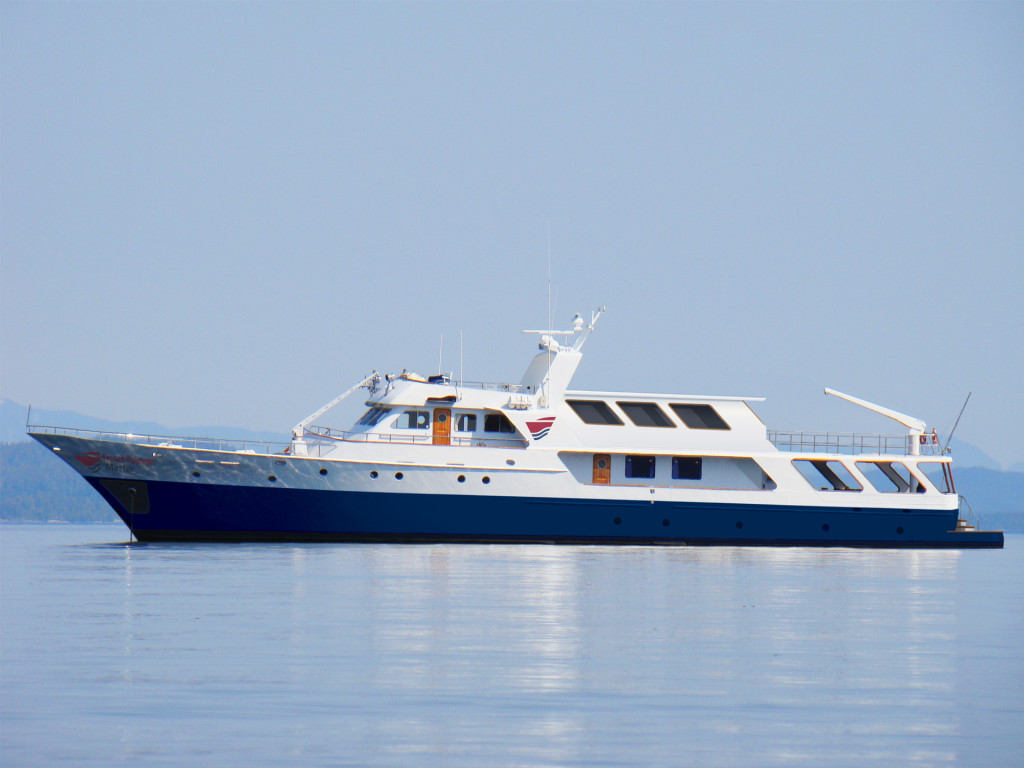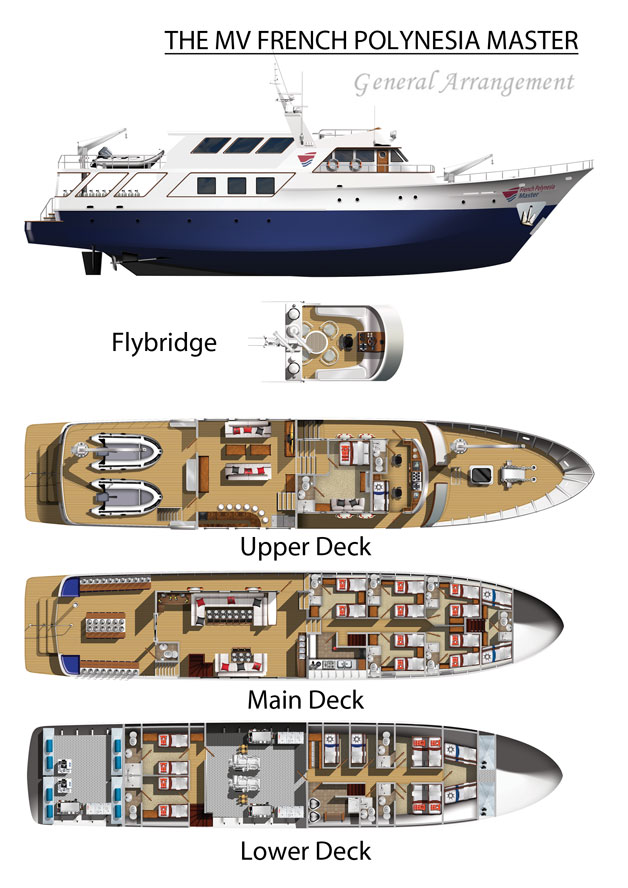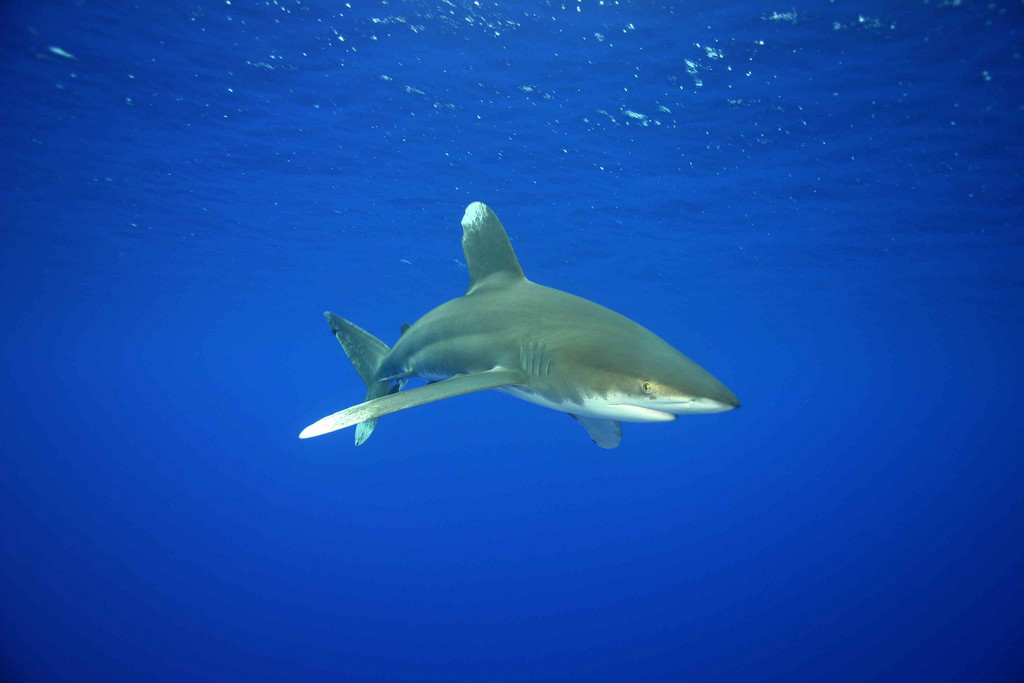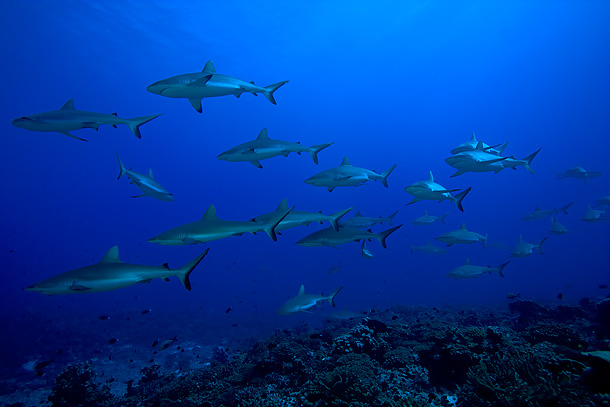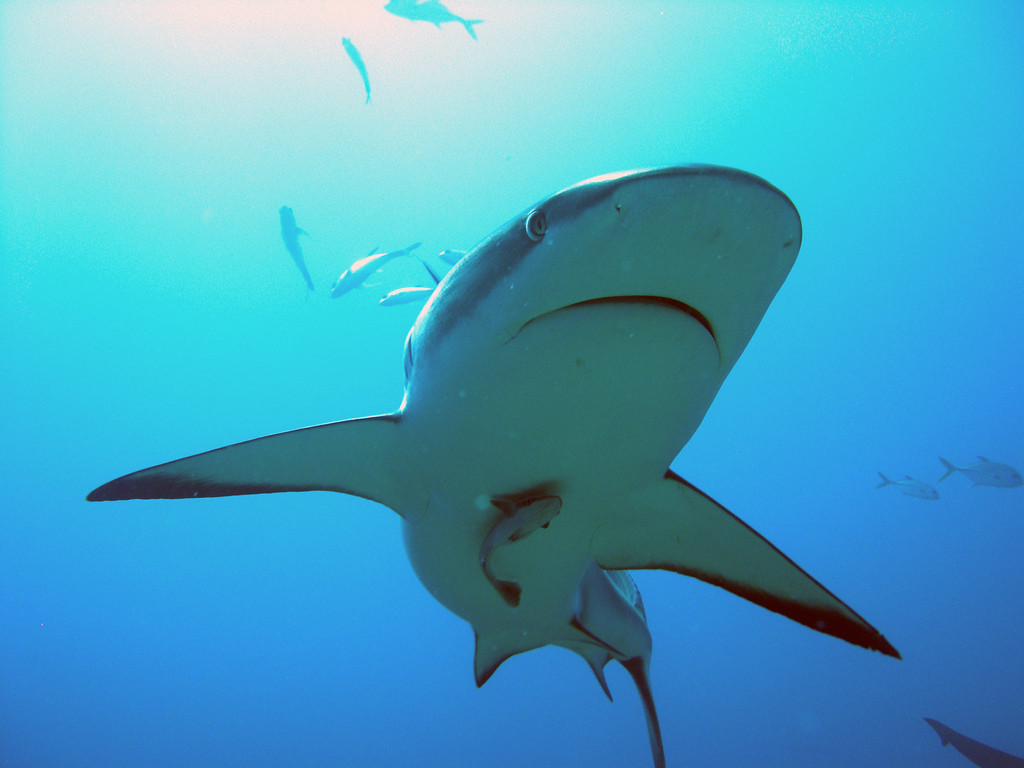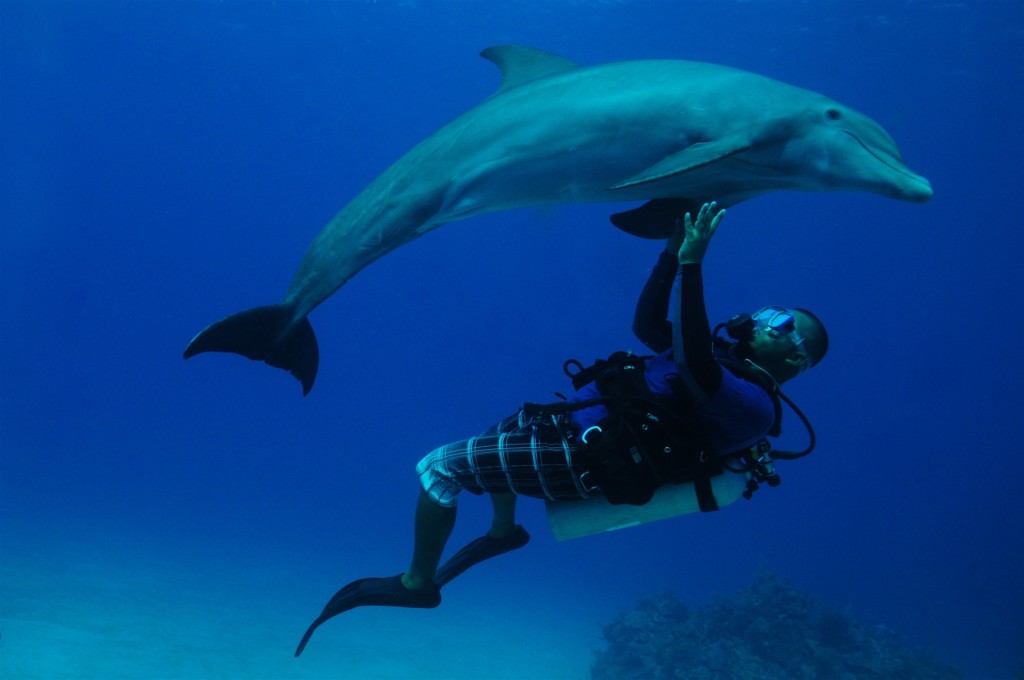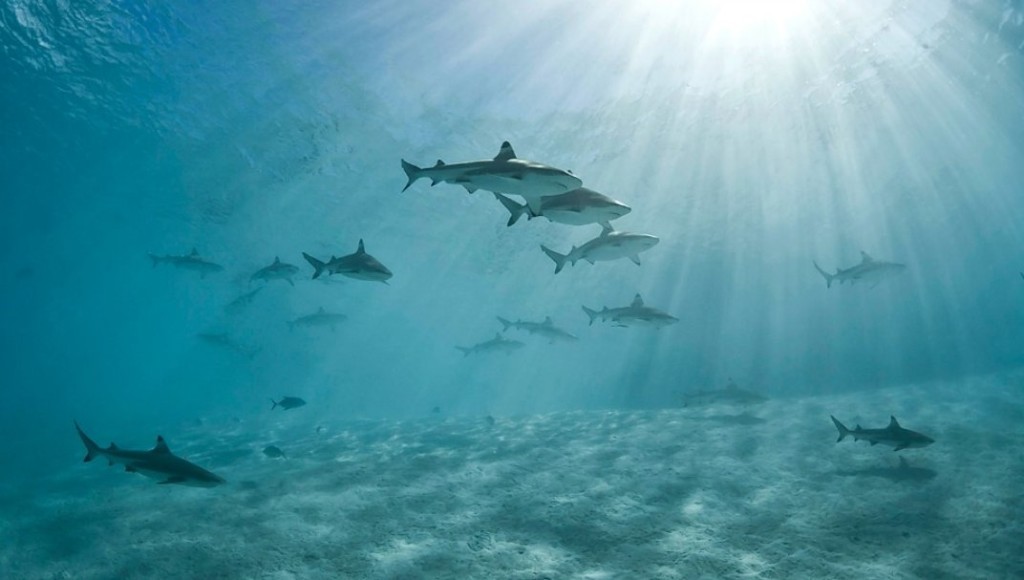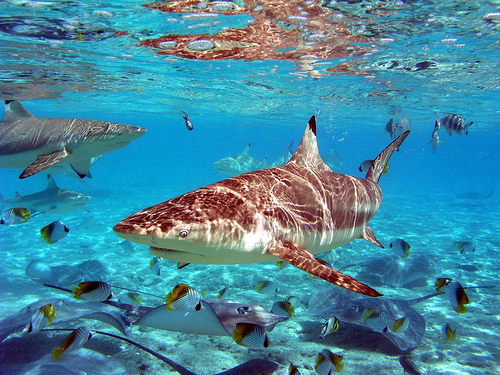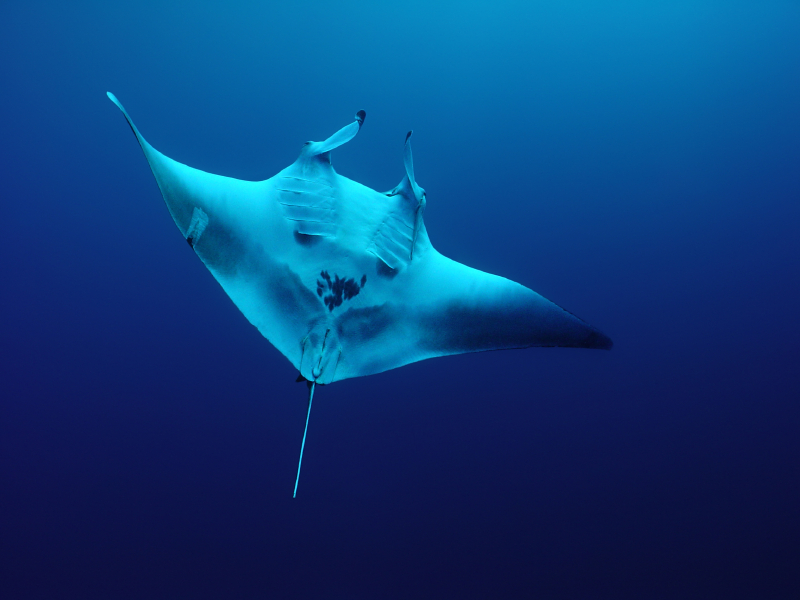Worldwide Dive and Sail (WWDAS) who designed, built and operate the Siren Fleet liveaboard brand came up with the plan to expand their list of highly-rated, amazing dive destinations. Combining more than 70 years boat building experience, in both wood and steel boats, it was the logical step for Jan and Frank van der Linde to move into re-building steel vessels. The team will also offer advice to other vessel owners on how to operate and maintain their boats to the highest standards; and thus the Master Liveaboards brand was born.
By taking and utilising the diving knowledge and liveaboard operation experience of the WWDAS team you can expect the standard of operation to rise in many different destinations.
Their aim remains simple; to push dive industry standards and provide our guests with an unsurpassed liveaboard diving experience.
The French Polynesia Master Liveaboard has just been announced and the first trips will run from May 2016.
The diving day aboard the French Polynesia Master has a typical schedule as follows:-
- Light Breakfast followed by a briefing & Dive 1
- Full Breakfast, relaxation period, briefing & Dive 2
- Lunch, relaxation period, briefing & Dive 3
- Snack relaxation period, briefing & Dive 4, where possible
- Dinner
A number of different itineraries will be offered with different duration’s of 7, 10 and even 14 days.
Itinerary # 1
Fakarava and the UNESCO Biosphere Reserve
You will dive Fakarava Island in depth, however your dive team will also provide for dives at the numerous smaller islands along the way including Toau, Kauehi, Faaite, Niau and Raraka, which make up the UNESCO Biosphere Reserve. On a typical 7-night itinerary we will offer between 18-20 dives. The following is a description of the dive sites we may visit during your 7-night liveaboard safari aboard the M/V French Polynesia Master.
Fakarava Island
Garaue Pass — The northernmost channel of Fakarava Island and arguable the best site in the region for consistent shark sightings. The pass itself is 1600m wide and should only be dived at slack water due to the very strong currents. Starting at the outer wall we encounter the huge ‘‘wall of sharks’’ where hundreds of greys congregate. Black tip, white tip, hammerhead, tiger, silky and oceanic white tip are amongst the other species seen. Napoleon wrasse, surgeon fish and the typical schools of big eyes and yellow snapper swarm over the reefs, joined by turtles, morays and lionfish. In June and July, large numbers of grouper aggregate to spawn, a truly spectacular sight. Manta rays also visit.
Maiuru — A submerged plateau on the outer edge of the pass, levels out at 18m into a lovely hard coral garden. At the ‘drop off’ you can encounter shark activity, whilst over the reef large schools of paddletail snapper and barracuda form. Manta rays and eagle rays come by for cleaning and a quick meal and there are plenty of smaller creatures including nudibranchs and crabs to spot amongst the corals and sponges.
Ohutu — The second plateau starts at 12m and drops to 30m with vibrant corals this is a superb place to watch manta rays.
Restaurant Pier — This shallow site is perfect for an afternoon dive where schools of snapper, black tip reef sharks and Napoleon wrasse are common with a stunning atmosphere for photography.
Tumakohua — The southern pass of Fakarava is just as dramatic as the north, though only 200m across, it can be dived with both ingoing and outgoing tides. Big schools of grey reef sharks can be seen in the deeper water whilst along the shallower reef black tips dart about. Manta rays and leopard whiprays are also frequently seen.
Toau Island
Otugi Pass — The 400m wide channel is best dived on an incoming tide for the schools of grey reef sharks and silvertips.
Teahuroa — The outer reef wall is where huge schools of snapper congregate. Reef sharks, Napoleon wrasse, barracuda, surgeon fish and big eyes join them, whilst manta ray sightings are possible too.
Kauehi Island
Outer Wall — The sloping outer wall of Kauehi Island is encrusted with huge hard coral formations and sponges. Butterfly fish, surgeon fish, banner fish and snappers all form large schools over the reef. Puffer fish, morays, tuna, barracuda, wrasse and lionfish are a common sight, whilst mantas, grey reef shark, eagle rays and the occasional hammerhead make up the larger visitors. Great for spotting leaf fish and nudibranchs too.
Itinerary # 2
Tuamotu Archipelago — French Polynesia
The following is a description of the dive sites we may visit during your liveaboard safari as the M/V French Polynesia Master cruises between Rangiroa and Fakarava. We have included the highlights; however the yacht may also stop at numerous smaller islands along the way including Arutua, Kankura and Niau. On a typical 7-night itinerary we will offer between 18-20 dives, 10-night itineraries up to 30 dives will be possible and 14-night itineraries we provide up to 42 dives.
Rangiroa Island
Tiputa Pass – Dropping in at the outer edge divers can hook in to the reef wall and watch the amazing shark display. Hammerheads, tiger shark and huge schools of grey reef shark are the main draw. Drift on the incoming tide through
The Canyons, where schools of big eyes hang out and mantas can be seen hanging in the cross current. End the dive at Shark Cave where white tips typically come to rest. Other common fish species are grouper and Napoleon
wrasse.
Tiputa Reef — On the ocean side of the pass the reef plateaus out at 20m into a magnificent coral garden. Schools of barracuda, turtles, white tip sharks, small wrasse and many colourful reef fish species can be seen. Mantas put in an
occasional appearance, bottle nose dolphins too.
Deep Blue – Or simply ‘‘The Blue’’ is the deep water on the ocean side of Tiputa Pass. Here we drop divers directly from the boat to descend to 20m and hang in the blue as the sharks are tempted up to the shallower depths by dropping stones. Expect to see grey reef, silky and silver tip sharks as well as bottlenose dolphins.
Nuhi Nuhi — A shallow coral garden where angel fish, butterfly fish, anthias and all manner of small creatures can be spotted. Look out for leaf fish.
Mypristis — The coral reef acts as a nursery for grey reef sharks in season. Typically divers can see large numbers of marbled grouper and many anemones with resident clown fish.
Avaturo Pass – Strong currents are to be expected but bring forth a wide range of pelagic species from reef sharks to tuna and the occasional sailfish.
Apataki Island
Tehere Pass — The strong currents through the pass mean divers can literally hang like a flag in the breeze! Reef hooks are essential if you want to stay and enjoy the hundreds of grey reef sharks hunting on fusiliers. Tuna, dolphins and swordfish can also be seen. The seabed and wall is more rubble than coral reef so simply drift in the current and enjoy the large pelagics.
Pakaka Pass — A more gentle drift than the Tehere Pass brings you through a pristine coral garden with table and staghorn corals. Silver tip and black tip reef sharks are seen darting in about the shallow corals, whilst numerous eagle rays are frequently sighted.
Toau Island
Otugi Pass — The 400m wide channel is best dived on an incoming tide for the schools of grey reef sharks and silvertips.
Teahuroa — The outer reef wall is where huge schools of snapper congregate. Reef sharks, Napoleon wrasse, barracuda, surgeon fish and big eyes join them, whilst manta ray sightings are possible too.
Fakarava North
Garaue Pass — The northernmost channel of Fakarava Island and arguable the best site in the region for consistent shark sightings. The pass itself is 1600m wide and should only be dived at slack water due to the very strong currents. Starting at the outer wall we encounter the huge ‘‘wall of sharks’’ where hundreds of greys congregate. Black tip, white tip, hammerhead, tiger, silky and oceanic white tip are among the other species seen. . Napoleon wrasse, surgeon fish and the typical schools of big eyes and yellow snapper swarm over the reefs, joined by turtles, morays and lionfish.
In June and July, large numbers of grouper aggregate to spawn, a truly spectacular sight. Manta rays also visit.
Maiuru — A submerged plateau on the outer edge of the pass, levels out at 18m into a lovely hard coral garden. At the ‘drop off’ you can encounter shark activity, whilst over the reef paddletail snapper and barracuda form large schools. Manta rays and eagle rays come by for cleaning and a quick meal and there are plenty of smaller creatures including nudibranchs and crabs to spot amongst the corals and sponges.
Ohutu — The second plateau starts at 12m and drops to 30m with vibrant corals this is a superb place to watch manta rays.
Restaurant Pier — This shallow site is perfect for an afternoon dive where schools of snapper, black tip reef sharks and Napoleon wrasse are common with a stunning atmosphere for photography.
Guests taking our 10-night itineraries will also have the option to dive the following areas:-
Fakarava South
Tumakohua — The southern pass of Fakarava is just as dramatic as the north, though only 200m across, it can be dived with both incoming and outgoing tides. Big schools of grey reef sharks can be seen in the deeper water whilst
along the shallower reef black tips dart about. Manta rays and leopard whiprays are also frequently seen.
Tikehau Island
In 1987 Jacques-Yves Cousteau dubbed Tikehau as ‘‘the richest atoll on the face of the earth’’, and it is easy to understand why with schools of sharks, manta rays and lovely corals.
Tuheiava Pass — A channel dive providing predictable encounters with grey reef and white tip reef sharks, schooling snappers in huge numbers and dolphins. Turtles and solitary barracudas are also seen.
The Shark Hole – Diving down a vertical break in the reef brings you through schooling sharks onto even bigger schools of snapper. The archway at 50m is adorned with anemones. The Old Pearl Farm — is THE place for watching mantas as they come to the reef for cleaning.
Kauehi Island
Outer Wall — The sloping outer wall of Kauehi Island is encrusted with huge hard coral formations and sponges. Butterfly fish, surgeon fish, banner fish and snappers all form large schools over the reef. Puffer fish, morays, tuna, barracuda, wrasse and lionfish are a common sight, whilst mantas, grey reef shark, eagle rays and the occasional hammerhead make up the larger visitors. Great for spotting leaf fish and nudibranchs.
Guests taking our 14-night itineraries will be able to dive at the areas listed above as well as the King George Islands of Manihi and Ahe.
Manihi
Tairapa Pass — Drift through the shallow channel at incoming tide for a spectacular view of reef sharks, Napoleon wrasse, manta rays and eagle rays. Jacks, triggerfish, moray eels and grouper are also amongst the common visitors.
The Circus — Dependent on currents this is a superb spot for consistent sightings of manta rays. Wathc as the graceful mantas come for feeding and cleaning. The visibility can drop to just 10m due to the plankton rich waters.
The Drop Off — On the Southwest of the Tairapa Pass this stunning wall drops to over 1500m . We of course don’t dive that deep! Staying at an average of 20m we encounter many white tip, black tip and grey reef sharks, large schools of tang and triggerfish and plenty of snappers.
West Point — This gentle dive with less current than at the channels, great for turtles, black tips, barracudas and groupers.
Added Information
Important information about diving in French Polynesia. This itinerary involves some long distance travel and whilst we attempt to ensure the number of dives we have scheduled is fulfilled, bad weather can hinder the boat’s ability to reach a specified dive site in good time. Many islands require the yacht to move within the atoll for safe overnight anchorage. Your cruise director and Captain will therefore plan the best route for entry to the atolls and to hit
the channel currents at the optimum time for diving. We wish to show you the very best diving possible yet the safety of all on board remains paramount. In the unlikely event we are unable to reach a specified dive site; we always do our best in offering diving at alternative locations.
Diving in French Polynesia can be challenging, even for the experienced diver. At many sites currents can be strong and whilst visibility is typically 20m+ it may diminish due to an influx of nutrients. Due to the strength of currents, diving at night is not always an option. We will offer 4 day dives, yet the 4th day dive may be substituted for a night dive where suitable.
Water temperature ranges from 24-28°C (75-82°F) with June-October being the coldest months. For most guests a 3mm long wetsuit will be sufficient, however those who feel the cold easily may wish to bring thicker exposure protection.
Should you have any questions or queries concerning the dive sites or whether this itinerary is suitable for your experience level, please contact our reservations team who will be pleased to assist and advise you.
For more information visit http://www.facesofthesea.com



